说在前面
封装的easyexcel,基于注解实现excel的导入导出,以场景来说,就是你有一个现成的分页接口或者一个list接口,只需要添加几个简单的注解,就可以实现excel的导出,也是为了方便有模板生成代码的情况下直接生成导出功能。
这是封装的依赖库源码:github.com/chenqi92/al...
这是这个依赖库的使用示例:github.com/chenqi92/al...
依赖库运行后在浏览器中打开:http://localhost:8080/ 即可测试各种示例,参照示例进行使用可以不用看后续的使用说明。
使用说明
添加maven依赖
xml
<dependency>
<groupId>cn.allbs</groupId>
<artifactId>allbs-excel</artifactId>
<version>3.0.1</version>
</dependency>普通导入
导入首先是需要提供用户一份模板的,用于让用户知道那一列填什么。如下有这么一个模板:

那么导入代码(直接返回展示,实际业务可以进行数据库储存)就是:
java
@PostMapping("/simple")
public ResponseEntity<?> simpleImport(@ImportExcel List<UserDTO> users) {
Map<String, Object> result = new HashMap<>();
result.put("success", true);
result.put("message", "导入成功");
result.put("count", users.size());
result.put("data", users);
return ResponseEntity.ok(result);
}
java
@Data
public class UserDTO {
@ExcelProperty(value = "用户ID", index = 0)
@NotNull(message = "用户ID不能为空")
private Long id;
@ExcelProperty(value = "用户名", index = 1)
@NotBlank(message = "用户名不能为空")
@Size(min = 2, max = 20, message = "用户名长度必须在2-20之间")
private String username;
@ExcelProperty(value = "邮箱", index = 2)
@Email(message = "邮箱格式不正确")
private String email;
@ExcelProperty(value = "创建时间", index = 3)
@DateTimeFormat("yyyy-MM-dd HH:mm:ss")
private LocalDateTime createTime;
@ExcelProperty(value = "年龄", index = 4)
private Integer age;
@ExcelProperty(value = "状态", index = 5)
private String status;
}带验证的导入,让用户和开发知道导入数据的哪一行存在问题
上述代码已经完成了一个导入功能,实际导入过程中难免遇到用户瞎填的情况,那么上面的UserDTO中字段上的校验就可以生效了。比如我不填用户名或者瞎填邮箱。
示例代码:
java
@PostMapping("/validate")
public ResponseEntity<?> importWithValidation(
@ImportExcel List<UserDTO> users,
@RequestAttribute(name = "excelErrors", required = false) List<ErrorMessage> excelErrors
) {
Map<String, Object> result = new HashMap<>();
if (!CollectionUtils.isEmpty(excelErrors)) {
// 使用默认格式化的错误消息
List<String> errors = excelErrors.stream()
.flatMap(em -> em.getErrorMessages().stream()
.map(msg -> "行号 " + em.getLineNum() + ":" + msg))
.collect(Collectors.toList());
result.put("success", false);
result.put("message", "数据验证失败");
result.put("errors", errors);
result.put("validCount", users.size());
result.put("errorCount", excelErrors.size());
return ResponseEntity.badRequest().body(result);
}
result.put("success", true);
result.put("message", "导入成功");
result.put("count", users.size());
result.put("data", users);
return ResponseEntity.ok(result);
}实际效果为:
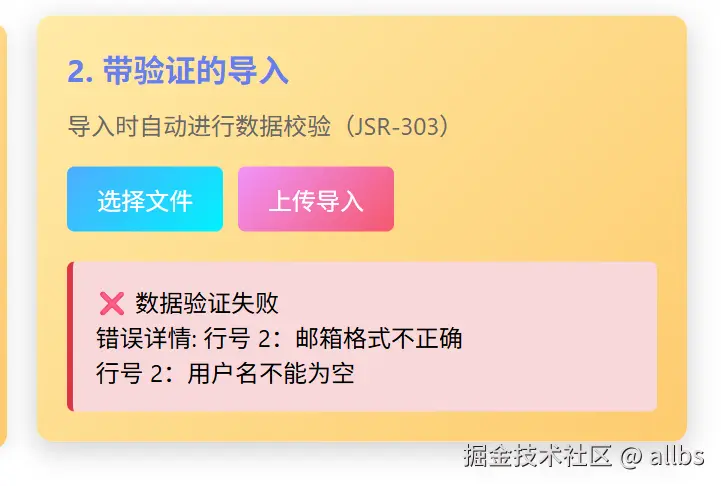
这是额外可以获取到的内容(errors中为简单的提示,fieldErrors内容较全,用于更多不同的业务场景使用):
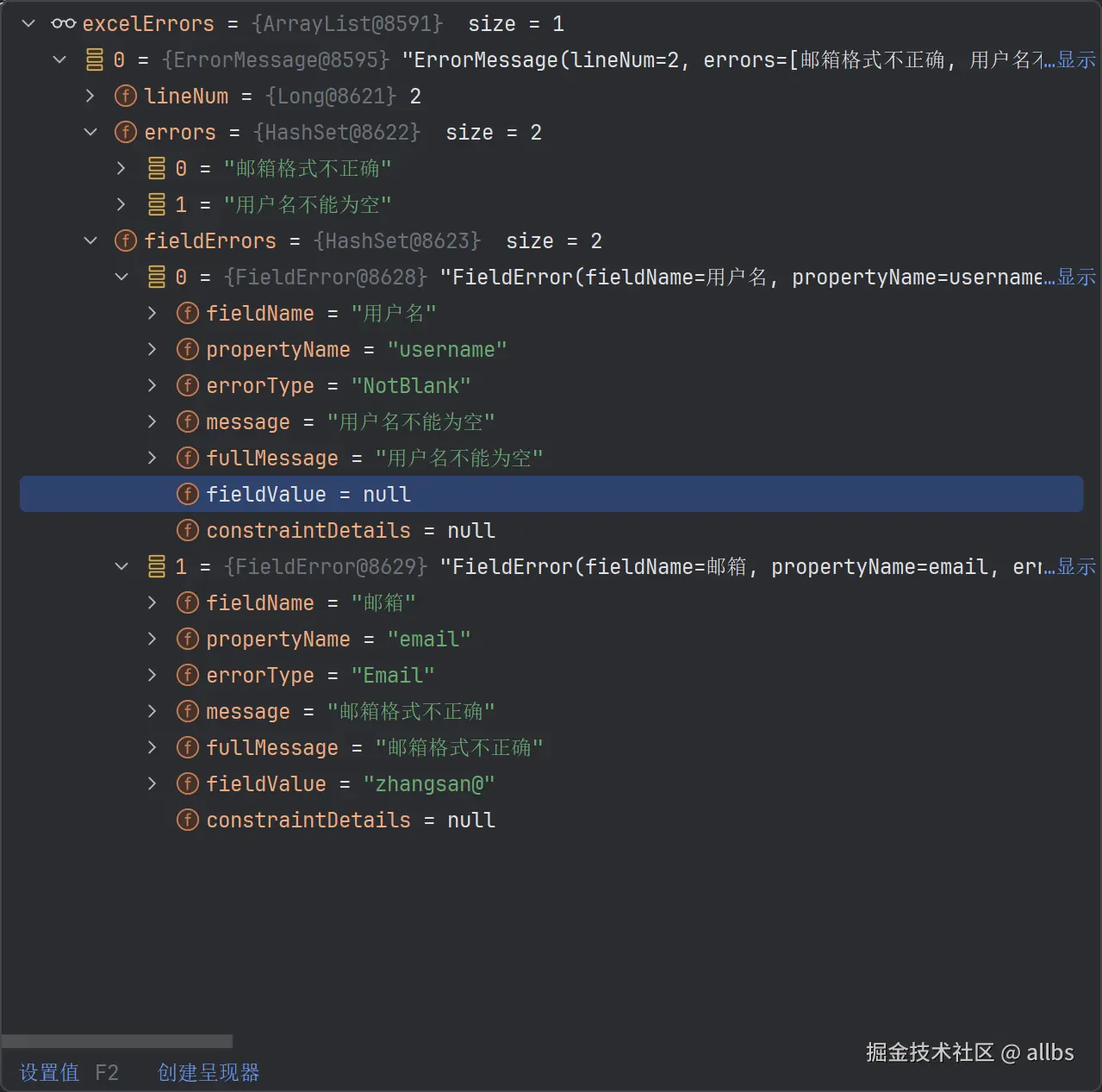
图片导入
首先是模板:

图片导入的示例代码(注意ProductImageDTO这个类中的关于图片字段的定义方式):
java
@PostMapping("/import")
public ResponseEntity<?> importWithImages(@ImportExcel List<ProductImageDTO> products) {
Map<String, Object> result = new HashMap<>();
result.put("success", true);
result.put("message", "导入成功");
result.put("count", products.size());
// 处理导入的数据
List<Map<String, Object>> productInfos = new ArrayList<>();
for (ProductImageDTO product : products) {
Map<String, Object> info = new HashMap<>();
info.put("id", product.getId());
info.put("name", product.getName());
info.put("price", product.getPrice());
info.put("stock", product.getStock());
info.put("description", product.getDescription());
// 图片信息
info.put("hasMainImage", product.getMainImage() != null && !product.getMainImage().isEmpty());
info.put("hasThumbnail", product.getThumbnail() != null && product.getThumbnail().length > 0);
info.put("imageListCount",
product.getImageList() != null ? product.getImageList().size() : 0);
// 如果需要,可以在这里保存图片到服务器
// saveImage(product.getMainImage(), "main_" + product.getId());
// saveImage(product.getThumbnail(), "thumbnail_" + product.getId());
productInfos.add(info);
}
result.put("products", productInfos);
log.info("Imported {} products with images", products.size());
return ResponseEntity.ok(result);
}
java
@Data
@NoArgsConstructor
@AllArgsConstructor
public class ProductImageDTO {
@ExcelProperty("商品ID")
private Long id;
@ExcelProperty("商品名称")
private String name;
@ExcelProperty("商品价格")
private BigDecimal price;
/**
* 商品主图(单张图片)
* <p>
* 导出时:支持 URL、本地路径、Base64
* 导入时:读取为 Base64 字符串
* </p>
*/
@ExcelProperty("商品主图")
@ExcelImage(width = 120, height = 120)
private String mainImage;
/**
* 商品缩略图(字节数组)
* <p>
* 导出时:直接使用字节数组
* 导入时:读取为字节数组
* </p>
*/
@ExcelProperty("商品缩略图")
@ExcelImage(width = 80, height = 80, type = ExcelImage.ImageType.BYTES)
private byte[] thumbnail;
/**
* 商品图集(多张图片)
* <p>
* 导出时:支持多张图片水平排列
* 导入时:读取为 Base64 字符串列表
* </p>
*/
@ExcelProperty(value = "商品图集", converter = ImageListConverter.class)
@ExcelImage(width = 100, height = 100)
private List<String> imageList;
@ExcelProperty("库存数量")
private Integer stock;
@ExcelProperty("商品描述")
private String description;
}实际导入后,debug可以获取到的内容为:
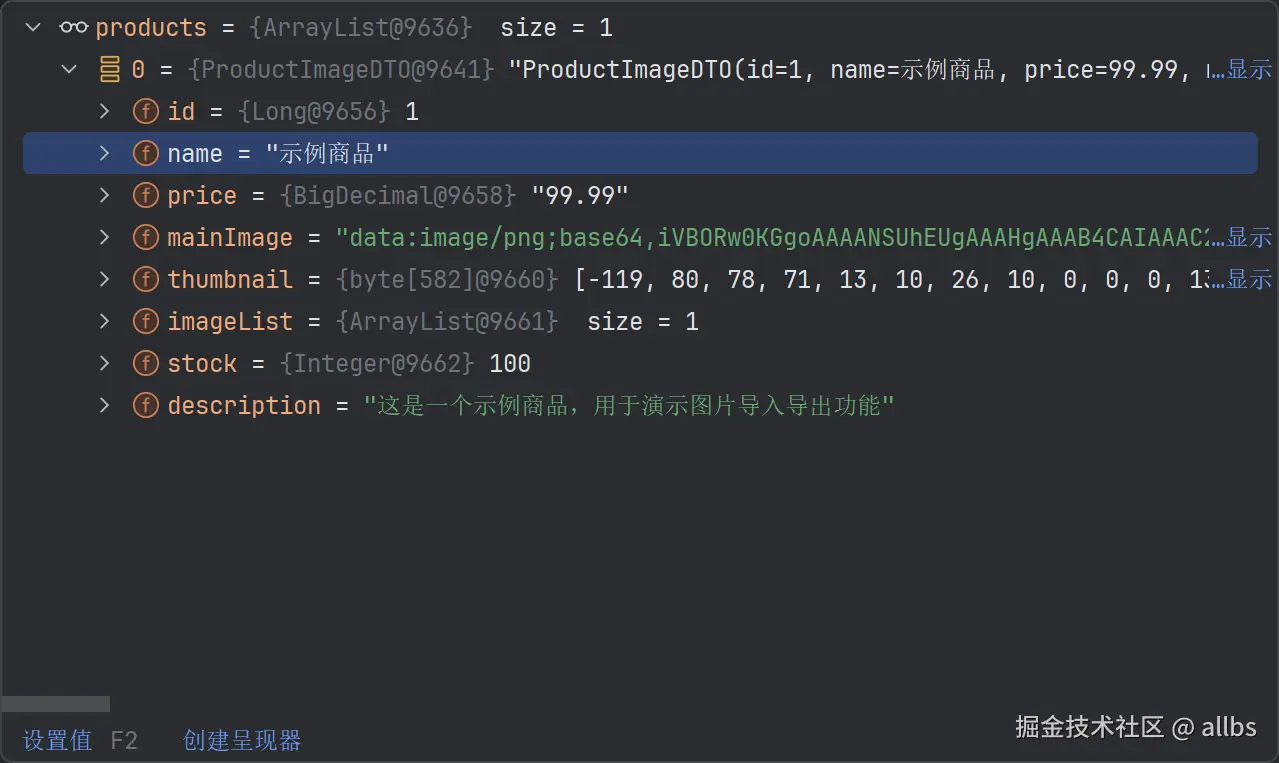
导出时这三列分别为base64的字符串、图片、图片。导入后获取到的内容为base64的字符串、转为二进制的数据、转为base64的图片。后续可以上传至minio等进行处理。
嵌套对象导入
这个是第二篇嵌套对象字段提取部分的数据导入。 对应的视图对象长这样,注意其中的@NestedProperty注解,其中department、department2、department3和department4实际上都只导出了一个字段:
java
@Data
@NoArgsConstructor
@AllArgsConstructor
public class NestedPropertyExampleDTO {
@ExcelProperty("员工ID")
private Long id;
@ExcelProperty("员工姓名")
private String name;
// ==================== 单层嵌套对象 ====================
@ExcelProperty(value = "部门名称", converter = NestedObjectConverter.class)
@NestedProperty("name")
private Department department;
@ExcelProperty(value = "部门编码", converter = NestedObjectConverter.class)
@NestedProperty(value = "code", nullValue = "未分配")
private Department department2;
// ==================== 多层嵌套对象 ====================
@ExcelProperty(value = "直属领导", converter = NestedObjectConverter.class)
@NestedProperty(value = "leader.name", nullValue = "暂无")
private Department department3;
@ExcelProperty(value = "领导电话", converter = NestedObjectConverter.class)
@NestedProperty(value = "leader.phone", nullValue = "-")
private Department department4;
// ==================== 集合类型 ====================
// 技能列表(内部字段,不导出)
@ExcelIgnore
private List<String> skills;
@ExcelProperty(value = "主要技能", converter = NestedObjectConverter.class)
@NestedProperty(value = "[0]", nullValue = "无")
private List<String> mainSkill;
@ExcelProperty(value = "所有技能", converter = NestedObjectConverter.class)
@NestedProperty(value = "[*]", separator = ",", maxJoinSize = 5)
private List<String> allSkills;
// ==================== Map 类型 ====================
// 扩展属性(内部字段,不导出)
@ExcelIgnore
private Map<String, Object> properties;
@ExcelProperty(value = "工作城市", converter = NestedObjectConverter.class)
@NestedProperty(value = "[city]", nullValue = "-")
private Map<String, Object> city;
@ExcelProperty(value = "入职年份", converter = NestedObjectConverter.class)
@NestedProperty(value = "[joinYear]", nullValue = "-")
private Map<String, Object> joinYear;
}所以使用该视图对象进行导入时,数据也会对应的缺少,如果想完整导入,看后面的示例。 这是导入使用的方法,和前面的实际上一样:
java
@PostMapping("/nested-property")
public Map<String, Object> nestedPropertyImport(@ImportExcel List<NestedPropertyExampleDTO> data) {
Map<String, Object> result = new HashMap<>();
result.put("success", true);
result.put("count", data.size());
result.put("data", data);
result.put("message", "成功导入 " + data.size() + " 条数据");
log.info("Imported {} records", data.size());
return result;
}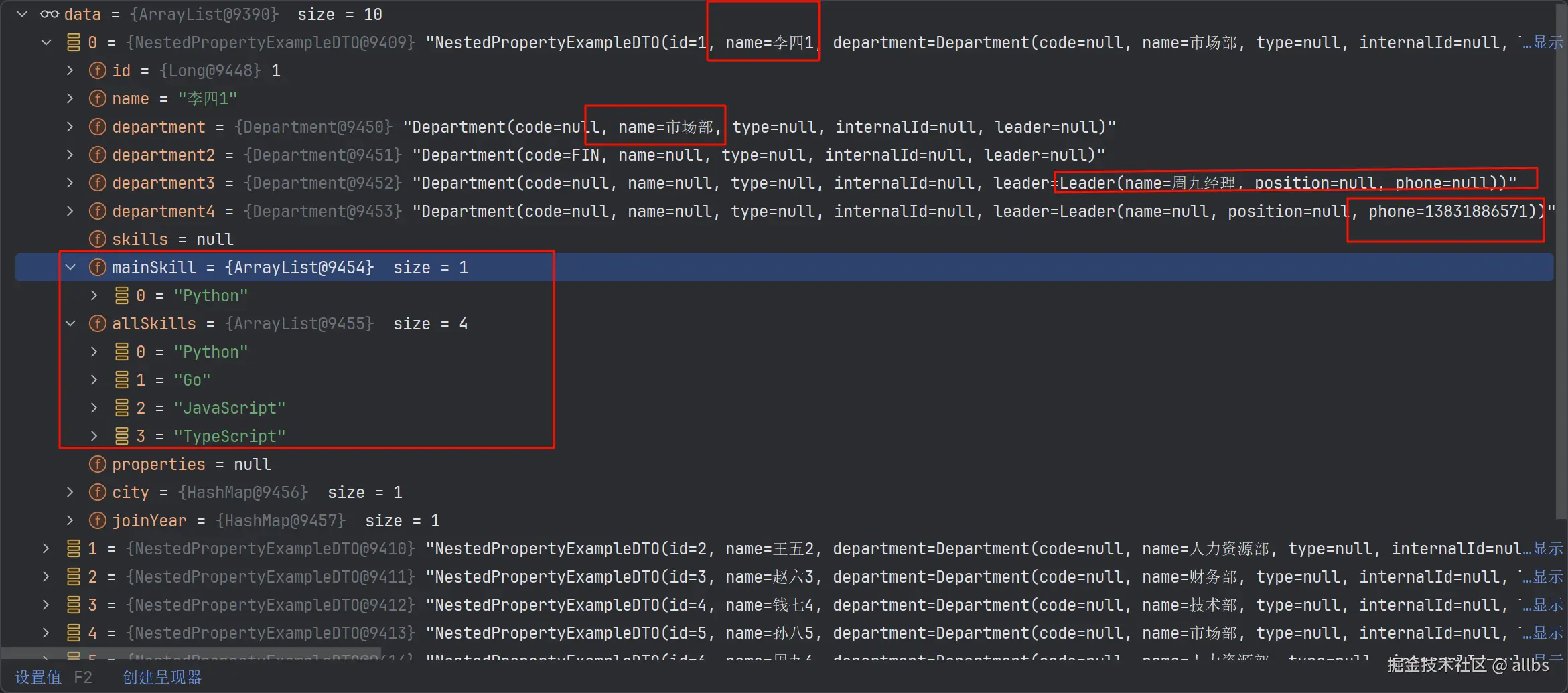
嵌套对象多行聚合导入
使用的是之前明细展开导出功能,大概可以理解为返回的对象list有5条数据,但是每条数据有子对象list,每个里面2条数据,实际上导出就是10条数据。
导出的内容示例为(实际接口返回list有5条数据,但是因为部分数据有子数据会自动撑开):

那么将这个多行聚合数据导入使用的代码示例为:
java
@PostMapping("/flatten-list-order")
public Map<String, Object> flattenListOrderImport(@ImportExcel List<FlattenListOrderDTO> data) {
Map<String, Object> response = new HashMap<>();
response.put("success", true);
response.put("count", data.size());
response.put("data", data);
response.put("message", "成功导入 " + data.size() + " 个订单");
log.info("Imported {} orders", data.size());
return response;
}接收到的数据为:
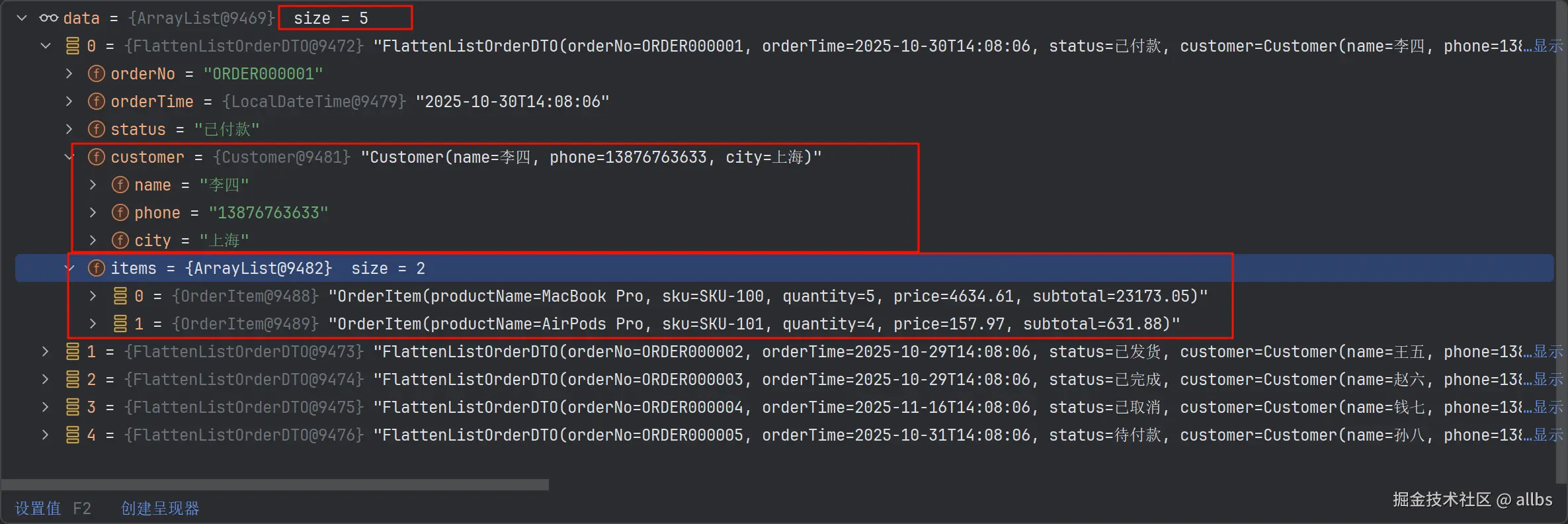
可以看到实际上也是五条数据,并且嵌套的对象list或者对象也正常将数据加载进去了。